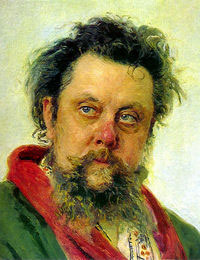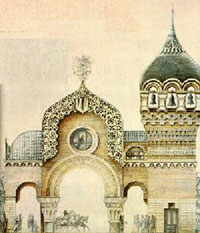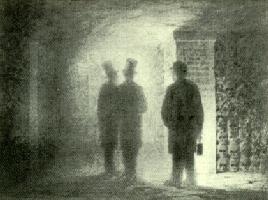|
When Modest Mussorgsky, the 19th century Russian composer, created Pictures at an Exhibition in memory of his friend, the artist and architect, Victor Hartmann, who died at the age of 39 of a heart attack, the two creative spirits were linked by mutual admiration for the inspirational value of folk art.  Mussorgsky composed the bravura piano suite, after a retrospective of Hartmann's work was exhibited in St. Petersburg, with over "400 paintings, costumes, architectural designs and sketches for ornamental household objects". Later, the suite was further enhanced by Maurice Ravel, the eminent and formidable French composer, who then orchestrated a "palette of instrumental effects" that took the work into sky high sonorous proportions. Since then the composition has been explored by a variety of composers, as well as contemporary musicians like Emerson, Lake and Palmer. Mussorgsky composed the bravura piano suite, after a retrospective of Hartmann's work was exhibited in St. Petersburg, with over "400 paintings, costumes, architectural designs and sketches for ornamental household objects". Later, the suite was further enhanced by Maurice Ravel, the eminent and formidable French composer, who then orchestrated a "palette of instrumental effects" that took the work into sky high sonorous proportions. Since then the composition has been explored by a variety of composers, as well as contemporary musicians like Emerson, Lake and Palmer.
I have a CD of Russian pianist Sviatoslav Richter's recital of Pictures at an Exhibition, recorded with a single microphone, in Sofia, Bulgaria (1958). Despite the low tech frugality of the recording, the riveting nature of Richter's interpretation absorbs the listener with its bold comprehension of no-holds-barred Russian monumentality, as well as the sensuous and sharply-defined rapid finger play in the detail.
The Rochester Philharmonic Orchestra, under the buoyant conducting of Christopher Seaman, presented Pictures at an Exhibition, along with Gunther Schuller's Seven Studies on Themes of Paul Klee , and Mozart's Concerto # 24 in C Minor for Piano and Orchestra, played engagingly by pianist Jonathan Biss. Schuller's work is new to me, and a challenge: for it too explores the relationship between music and painting, through the playful art of Paul Klee. Klee's paintings are musical by nature and tied also to a festive imagination, for he was a musician too. The colorful titles of Schuller's compact studies, like "Little Blue Devil", the jazz flavored "Twittering Machine", and "Eerie Moment" are reminiscent of Mussorgsky; although the music is as different as A to Z.
It was the creative excitement of Mussorgsky's "Pictures at an Exhibition," though, that absorbed me most. The music revived a youthful memory of when I first heard it. I listen to it now with a different set of ears. Maybe it is the Byelorussian bone response in me, for the music resonates in ways it never did before. When such a well known work is lifted by a gifted conductor, with an orchestra of fine musicians, many of whom teach at the famed Eastman School of Music, the music opens up in sharply regulated and vital ways.
The Mussorgsky/Ravel work uses as a jumping off place the musical architecture of a promenade through the Victor Hartmann exhibition.  It unfolds with ten segments of festive, majestic, mysterious and folkloric revelations. "Promenade" introduces the suite with quick time signatures, uplifted with a brass enclave of robust tonality: that of a grand gentlemen leisurely out for a stroll. It is immediately followed by, and contrasted with, the vision of a "Gnome" – a nutcracker segment that hypnotizes with its grotesque musical accessories. "The Old Castle" has a medieval feel to it, sustained by a low continuing bass note, transformed by Ravel into the yearning of an alto saxophone – almost lovelorn in its appeal. "Tuilerries", a scherzo, has a dancelike atmosphere, depicting children wandering in a Parisian garden, mollified by the somber voice of a tuba; like a nun telling them to quiet down. "Bydlo'" envisions the lumbering approach of an ox cart, slogging through the mud with "large, heavy wheels". The Promenade theme reprises, graduates and subsides throughout the work, from one segment to the next, with continuous creative junctions. "The Ballet of Little Chicks in Their Shells", a Hartmann costume sketch for the ballet "Trilby", where the heads of canaries break out of large shells, is up to the brim with funny, light-hearted, and perky woodwinds delighting the ear. It unfolds with ten segments of festive, majestic, mysterious and folkloric revelations. "Promenade" introduces the suite with quick time signatures, uplifted with a brass enclave of robust tonality: that of a grand gentlemen leisurely out for a stroll. It is immediately followed by, and contrasted with, the vision of a "Gnome" – a nutcracker segment that hypnotizes with its grotesque musical accessories. "The Old Castle" has a medieval feel to it, sustained by a low continuing bass note, transformed by Ravel into the yearning of an alto saxophone – almost lovelorn in its appeal. "Tuilerries", a scherzo, has a dancelike atmosphere, depicting children wandering in a Parisian garden, mollified by the somber voice of a tuba; like a nun telling them to quiet down. "Bydlo'" envisions the lumbering approach of an ox cart, slogging through the mud with "large, heavy wheels". The Promenade theme reprises, graduates and subsides throughout the work, from one segment to the next, with continuous creative junctions. "The Ballet of Little Chicks in Their Shells", a Hartmann costume sketch for the ballet "Trilby", where the heads of canaries break out of large shells, is up to the brim with funny, light-hearted, and perky woodwinds delighting the ear.
"Samuel Goldenberg and Schmuyle" represents two Polish Jews, one a musical figure of a "rich and pompous" Jew (low strings), and the other a down-and-out poor one(a muted trumpet); an interlocking embrace of alternating voices in muted conversation. Invention takes yet another turn with "Limoges" – a bustling market place. In the original score, Mussorgsky notated rival female venders within a lively squabble of competitive musical pitching. The music then shifts mysteriously to the "Catacombs", a Roman burial ground beneath the streets of Paris.
 Inspired by a Hartman portrait of himself walking through the catacombs, where human skulls with candles through off an eerie glow, strongly suggests Hartman's early death; and, in retrospect, also feels now to be prophetic of Moussorky's stressful impending one, as well. "With the Dead in a Dead Language" collates that musical lock into a haunting "ghostly whisper"; other worldly and prophetic. It's amazing how an historical reference appears prophetic in hindsight—almost a subcutaneous fraction of an inch divides reality from fantasy. Inspired by a Hartman portrait of himself walking through the catacombs, where human skulls with candles through off an eerie glow, strongly suggests Hartman's early death; and, in retrospect, also feels now to be prophetic of Moussorky's stressful impending one, as well. "With the Dead in a Dead Language" collates that musical lock into a haunting "ghostly whisper"; other worldly and prophetic. It's amazing how an historical reference appears prophetic in hindsight—almost a subcutaneous fraction of an inch divides reality from fantasy.
I have had the experience of lingering in Istanbul's famous below-the-ground aqueduct, where the sculpted head of the Roman emperor, Constantine, lies faintly glowing beneath the water with leftover sunlight spilling in from above. And I can still hear the ghostly echoes of the chambers surrounding me, like the whispers of the lost voices of history.
Pictures at an Exhibition is a large musical envelope of a stirred and vital aural imagination. Ravel's orchestrated suites, like the original Mussorgsky piano score, has an awed and inspired quality; a jumping off place for compositional dynamics that linger in memory long after time has passed on - to another time. Unlike Tschaikovsky's 1812 overture, with its bombastic ending, Mussorgsky/Ravel's "Pictures at an Exhibition" challenges the imagination, by tranferring the initial visual impressions of Hartmann's art work into a growing dynamic of musical brilliance - whole, powerful, absorbing, and structurally intact.
|
